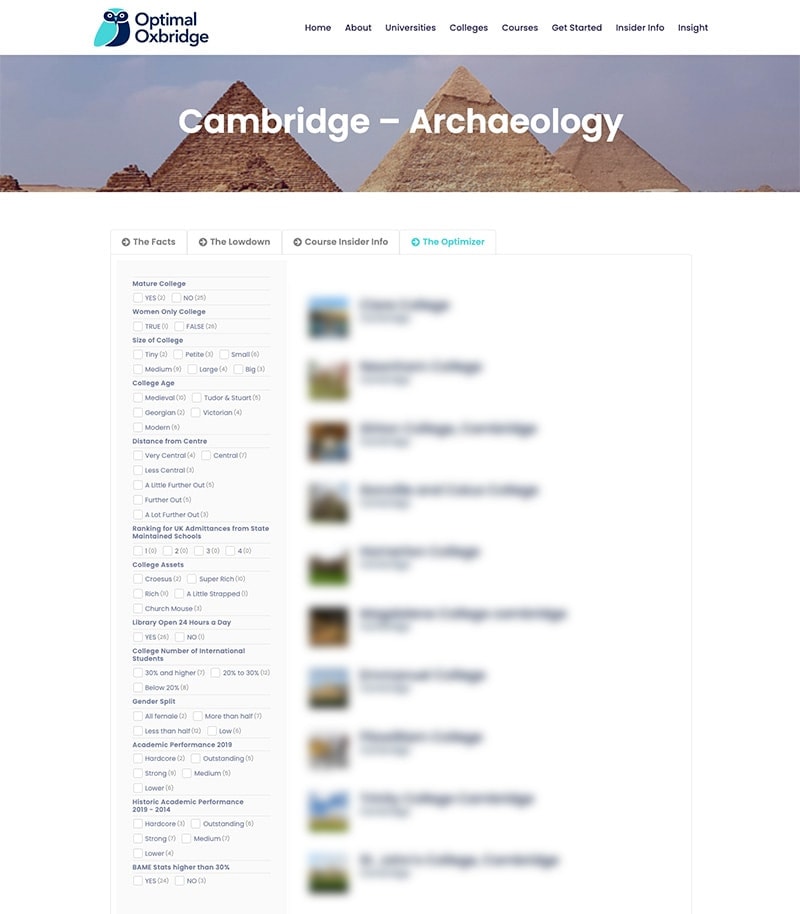Subscribe for full access to insider info and the optimizer.
Unlock access to the Optimizer and Insider Info
Let our optimizer help you find your college match faster. We’ll screen out the bad fits so that you can review the schools you’ll like best. Who knows? You might find a college you never knew existed.
The Facts
UCAS Code:
K100
Standard Requirements:
A levels| A*AA / A*A*A ( depends on college, sometimes Churchill requires A*A*A with an A* in A Level Mathematics and/or A* in A Level Physics. Gonville & Caius requires A* in A Level Physics or Mathematics and Sidney Sussex requires an A Level in Mathematics and/or Physics)
IB | 40-42 points, 776 at Higher Level
For other qualifications, check the Cambridge University website.
Required Subjects:
Physics or Mathematics ( by some colleges), an essay centered subject (by some colleges)
Advisable Subjects:
None stated by the university.
None stated by the university.
An artwork portfolio of 6 A4 pages, less than 15 MB reflecting personal interest through photographs, sketches, 3D illustrations. Submitted work can include creative work done outside of school as well as materials prepared for final examinations.A sketchbook with outlines is highly recommended to take to the interview.
66 (11% offered, 10% accepted)

The Lowdown
This course combines historical, cultural, and creative studies, and prepares students well for a career as an architect. The department is tight-knit and incredibly supportive. You will be taught through a combination of studio days and lectures, and Cambridge offers several facilities for these including libraries, studio, and reprographics spaces. Thus, this degree offers you a solid academic and practical grounding in architectural theories and methods.
In first year, you will cover basic architectural drawing methods in your studio classes, alongside five taught papers. Most of your teaching takes place in the studio, rather than in the lecture hall, though you will also be expected to write supervision essays. Your papers cover the history of architecture, both pre-and post-1800, and groundwork in construction, structural and environmental design. You will usually have a trip abroad during the Easter holidays.
In the second year, you have more options for specialising in the type of studio work you are interested in, alongside another five papers (all of which are extensions of topics studied in Year 1). A voluntary study trip will also be available to all students.
In your final year, you will choose a studio pathway, alongside four papers and a written dissertation. These papers represent higher-level studies in history/theory, management, technology, and engineering.
This is a competitive course (and also a predominantly female course, with only 20% of 2020 offers going out to male students), and applicants have only had a 10% success rate over the last three years. It is, therefore, important that you demonstrate proficiency in both arts and science subjects, as well as a strong passion for drawing at A-Level (or equivalent). Some colleges also require an A-Level in Maths or Physics and an essay-based subject.
This degree qualifies as your ARB/RIBA Part 1, which you can carry on to Parts 2 and 3, either via a 2-year Masters followed by a 1-year Postgraduate course, or a part-time internship (lasting four years). Most students do this, though some have embarked upon a diverse range of research pathways, including design, ecology, and philosophy.
Unlock Insider Info
Get insider intel about how to increase your chances of being offered a place, plus access interviews tips and special questions.
The Optimizer
Unlock access to the optimizer
Let our optimizer help you find your college match faster. We’ll screen out the bad fits so that you can review the schools you’ll like best. Who knows? You might find a college you never knew existed.

